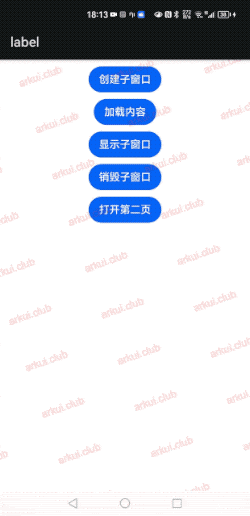# 7.6:窗口模块(Window)
窗口模块用于在同一物理屏幕上,提供多个应用界面显示、交互的机制。
- 对应用开发者而言,窗口模块提供了界面显示和交互能力。
- 对于终端用户而言,窗口模块提供了控制应用界面的方式。
- 对于操作系统而言,窗口模块提供了不同应用界面的组织管理逻辑。
OpenHarmony 将窗口分为系统窗口和应用窗口两种类型:
系统窗口:
系统窗口指完成系统特定功能的窗口。如音量条、壁纸、通知栏、状态栏、导航栏等。
应用窗口:
应用窗口区别于系统窗口,指与应用显示相关的窗口。根据显示内容的不同,应用窗口又分为应用主窗口、应用子窗口两种类型。
应用主窗口:
应用主窗口用于显示应用界面,会在“任务管理界面”显示。
应用子窗口:
应用子窗口用于显示应用内的弹窗、悬浮窗等辅助窗口,不会在“任务管理界面”显示。
ArkUI 开发框架在 @ohos.window 模块中提供了对窗口操作相关方法,比如设置窗口全屏显示,弹出悬浮窗等,本节笔者简单介绍一下窗口模块。
# 7.6.1:Window 定义介绍
declare namespace window {
function create(id: string, type: WindowType): Promise<Window>;
function find(id: string): Promise<Window>;
function getTopWindow(): Promise<Window>;
// Winodw 的能力
interface Window {
show(): Promise<void>;
destroy(): Promise<void>;
moveTo(x: number, y: number): Promise<void>;
resetSize(width: number, height: number): Promise<void>;
getAvoidArea(type: AvoidAreaType): Promise<AvoidArea>;
setFullScreen(isFullScreen: boolean): Promise<void>;
setLayoutFullScreen(isLayoutFullScreen: boolean): Promise<void>;
loadContent(path: string): Promise<void>;
isShowing(): Promise<boolean>;
on(type: 'windowSizeChange' | 'systemAvoidAreaChange' | 'keyboardHeightChange', callback: Callback<Size>): void;
off(type: 'windowSizeChange' | 'systemAvoidAreaChange' | 'keyboardHeightChange', callback?: Callback<Size>): void;
setBackgroundColor(color: string): Promise<void>;
}
}
export default window;
2
3
4
5
6
7
8
9
10
11
12
13
14
15
16
17
18
19
20
21
22
@kit.ArkUI 模块提供的静态方法及 Window 的部分方法说明如下:
create():创建一个子窗口。
find():查找指定
id所对应的窗口getTopWindow():获取当前应用内最后显示的窗口。
show():显示当前窗口。
destroy():销毁当前窗口。
moveTo():移动当前窗口。
on():监听窗口对应事件。
off():取消监听对应窗口事件。
setLayoutFullScreen():设置窗口布局是否为全屏布局。
loadContent():为当前窗口加载具体页面内容。
setBackgroundColor():设置窗口的背景色。
setSystemBarEnable():设置导航栏、状态栏是否显示。
setFullScreen():设置窗口是否全屏显示。
# 7.6.2:Window 使用介绍
引入 window 模块
import { window } from '@kit.ArkUI'1创建 Window 对象
创建一个
Window,直接调用 create() 相关方法即可,笔者创建的一个窗口类型为TYPE_APP的子窗口,代码如下:private createSubWindow() { window.createWindow({ name: this.subWindowID, windowType: window.WindowType.TYPE_FLOAT }).then((subWindow) => { if (subWindow) { this.subWindow = subWindow this.subWindow.setWindowFocusable(false) this.subWindow.resize(750, 480) this.subWindow.moveWindowTo(230, 1200) this.subWindow.setWindowBackgroundColor(Color.Red.toString()) this.subWindow.setWindowTouchable(false) this.status = "create subWindow success" } else { this.status = "create subWindow failure: " + JSON.stringify(subWindow) } }).catch((error: BusinessError) => { this.status = "create subWindow failure: " + JSON.stringify(error) }) }1
2
3
4
5
6
7
8
9
10
11
12
13
14
15
16
17
18
19
20创建 Widnow 页面
Window创建完成后,就可以用它来加载待显示的页面了,先创建一个页面并命名为sub_window.ets,然后用刚刚创建的Window对象来加载,页面代码如下:@Entry @Component struct SubWindowComponent { build() { Column() { Text("我是子窗口") .fontSize(30) } .backgroundColor("#ccaabb") .size({width: "100%", height: "100%"}) } }1
2
3
4
5
6
7
8
9
10📢:子窗口加载的页面需要在配置文件
config.json中的 pages 属性中添加进来,否则加载不进来,页面就显示不出来。加载 Window 页面
加载页面直接调用
Window的 loadContent() 方法即可,代码如下所示:private loadContent(path: string) { if (this.subWindow) { this.subWindow.setUIContent(path).then(() => { this.status = "load content success" }).catch((error: BusinessError) => { this.status = "load content failure: " + JSON.stringify(error) }) } else { this.status = "subWindow not created" } }1
2
3
4
5
6
7
8
9
10
11显示 Window 页面
Window加载完页面后还要调用它的 show() 方法,否则页面不显示。代码如下所示:private showSubWindow() { if (this.subWindow) { this.subWindow.showWindow().then(() => { this.status = "show subWindow success" }).catch((error: BusinessError) => { this.status = "show subWindow failure: " + JSON.stringify(error) }) } else { this.status = "subWindow not created" } }1
2
3
4
5
6
7
8
9
10
11销毁 Window 页面
在
Window使用完毕后,应当及时销毁它,以便资源被回收,代码如下所示:private destroySubWindow() { if (this.subWindow) { this.subWindow.destroyWindow().then(() => { this.status = "destroy subWindow success" this.subWindow = null }).catch((error: BusinessError) => { this.status = "destroy subWindow failure: " + JSON.stringify(error) }) } else { this.status = "subWindow already destroyed" } }1
2
3
4
5
6
7
8
9
10
11
12
# 7.6.3:Window 完整样例
使用 @ohos.window 模块提供的 API 创建一个 Window 并显示和销毁,完整代码如下所示:
import { router, window } from '@kit.ArkUI'
import { BusinessError } from '@ohos.base'
@Entry @Component struct Index {
@State status: string = "";
private subWindowID = "subWindowID"
private subWindow?: window.Window | null = null
build() {
Column({space: 10}) {
Button("创建子窗口")
.onClick(() => {
this.createSubWindow()
})
Button("加载内容")
.onClick(() => {
this.loadContent("pages/sub_window")
})
Button("显示子窗口")
.onClick(() => {
this.showSubWindow()
})
Button("销毁子窗口")
.onClick(() => {
this.destroySubWindow()
})
Button("打开第二页")
.onClick(() => {
router.pushUrl({
url: "pages/second" // second 页面读者请自行添加
})
})
Text(this.status)
.fontSize(24)
}
.width('100%')
.height("100%")
.backgroundColor(Color.White)
.padding(10)
}
private destroySubWindow() {
if (this.subWindow) {
this.subWindow.destroyWindow().then(() => {
this.status = "destroy subWindow success"
this.subWindow = null
}).catch((error: BusinessError) => {
this.status = "destroy subWindow failure: " + JSON.stringify(error)
})
} else {
this.status = "subWindow already destroyed"
}
}
private showSubWindow() {
if (this.subWindow) {
this.subWindow.showWindow().then(() => {
this.status = "show subWindow success"
}).catch((error: BusinessError) => {
this.status = "show subWindow failure: " + JSON.stringify(error)
})
} else {
this.status = "subWindow not created"
}
}
private loadContent(path: string) {
if (this.subWindow) {
this.subWindow.setUIContent(path).then(() => {
this.status = "load content success"
}).catch((error: BusinessError) => {
this.status = "load content failure: " + JSON.stringify(error)
})
} else {
this.status = "subWindow not created"
}
}
private createSubWindow() {
window.createWindow({
name: this.subWindowID,
windowType: window.WindowType.TYPE_FLOAT
}).then((subWindow) => {
if (subWindow) {
this.subWindow = subWindow
this.subWindow.setWindowFocusable(false)
this.subWindow.resize(750, 480)
this.subWindow.moveWindowTo(230, 1200)
this.subWindow.setWindowBackgroundColor(Color.Red.toString())
this.subWindow.setWindowTouchable(false)
this.status = "create subWindow success"
} else {
this.status = "create subWindow failure: " + JSON.stringify(subWindow)
}
}).catch((error: BusinessError) => {
this.status = "create subWindow failure: " + JSON.stringify(error)
})
}
}
2
3
4
5
6
7
8
9
10
11
12
13
14
15
16
17
18
19
20
21
22
23
24
25
26
27
28
29
30
31
32
33
34
35
36
37
38
39
40
41
42
43
44
45
46
47
48
49
50
51
52
53
54
55
56
57
58
59
60
61
62
63
64
65
66
67
68
69
70
71
72
73
74
75
76
77
78
79
80
81
82
83
84
85
86
87
88
89
90
91
92
93
94
95
96
97
98
99
100
101
102
103
104
105
106
样例样式结果如下图所示:

# 7.6.4:小结
本节通过简单的样例向读者介绍了 Window 的基本使用,更多其它 API 的用法,请读者自行参考官方文档。通过样例可以方便的实现 APP 内的全局弹窗,这比在 Android 系统上实现要简单的多(#^.^#)

